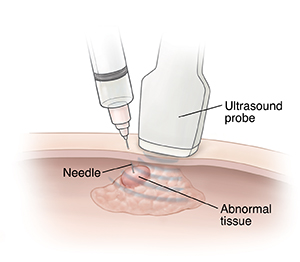Image-Guided Biopsy
A biopsy is a small sample of tissue or fluid taken from your body. This sample is then studied in a lab. Image-guided biopsy lets your healthcare provider take a sample from an abnormal lump (mass) without using surgery. Image-guided biopsies use ultrasound, X-ray, CT scan, or MRI images to find exactly where to place the needle and do the biopsy. This procedure is done by a radiologist. It can also be done by a specially trained healthcare provider called an interventional radiologist.
 |
| A needle is used to take a sample of tissue from inside the body. |
Before your procedure
-
Tell your healthcare provider about any health conditions you have
-
Tell your provider about all medicines you are taking. This includes all prescription and over-the-counter medicines, vitamins, herbs, or supplements. This also includes any illegal drugs.
-
Tell your provider if you're allergic to any medicines.
-
Tell your provider if you're pregnant or think you may be pregnant.
-
Follow all directions you're given for not eating or drinking before the procedure.
-
Follow any other instructions from your provider.
During your procedure
-
You may be asked to change into a hospital gown and lie on a special table. The table that's used will depend on the type of imaging that will guide the biopsy. You may lie on your back, front, or side. Your position depends on where the biopsy is to be done.
-
An IV (intravenous) line may be started. This will give you fluids and medicines. You may be given medicine through the IV to help you relax.
-
The skin over the biopsy site is cleaned. Medicine will be injected through the skin.to numb the area.
-
The radiologist will use CT scan, MRI, X-ray, or ultrasound images as a guide. They'll put a thin, hollow needle through the skin. It will be guided to the area where the biopsy will be done.
-
The needle will take a sample of tissue or fluid from the area. The needle is then taken out. The sample is sent to a lab. It will be checked under a microscope for cells that aren’t normal.
After your procedure
-
You'll most likely be able to go home either right away or in a few hours. This depends on what area was biopsied.
-
You may need to have a friend or family member drive you home.
-
Care for the insertion site as directed.
Possible risks
Possible risks and complications of an image-guided biopsy include:
-
Bleeding inside your body
-
Bruising or bleeding at the place where the needle was put in
-
Damage to body areas along the path of the needle
Online Medical Reviewer:
Neil Grossman MD
Online Medical Reviewer:
Raymond Turley Jr PA-C
Online Medical Reviewer:
Rita Sather RN
Date Last Reviewed:
4/1/2024
© 2000-2025 The StayWell Company, LLC. All rights reserved. This information is not intended as a substitute for professional medical care. Always follow your healthcare professional's instructions.